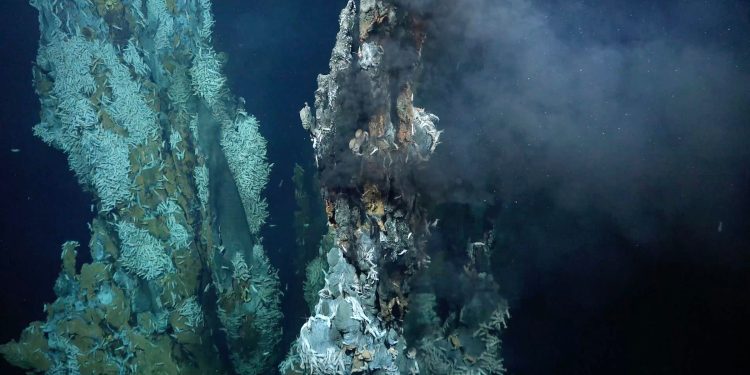Researchers from the International Ocean Discovery Program (IODP) recently retrieved one of the most significant geological samples from Earth’s mantle. This core, measuring over three-quarters of a mile (1.2 kilometers) in length, offers an unprecedented look into the geological processes that have shaped our planet over millions of years. Drilled from beneath the Atlantic Ocean, this core is not only the longest of its kind ever recovered, but it also provides crucial insights into the “plumbing” system beneath hydrothermal vents like those found at the Lost City, an active field on the Mid-Atlantic Ridge.
The Lost City: A Hydrothermal Marvel
The Mid-Atlantic Ridge, where the core was retrieved, is one of the few places on Earth where mantle material comes close to the surface, thanks to the slow spreading of tectonic plates. Just a half-mile away from the drilling site lies the Lost City Hydrothermal Field, a unique system of towering carbonate chimneys rising from the ocean floor. These chimneys, some reaching heights of over 200 feet (60 meters), vent warm, hydrogen-rich fluids that support a thriving ecosystem of microbes and other life forms. The Lost City is unlike most other hydrothermal vent systems, which are fueled by volcanic activity. Instead, it is powered by chemical reactions between seawater and mantle rocks, making it a prime location for studying life in extreme environments and understanding the potential origins of life on Earth.
Unveiling the Secrets of Earth’s Mantle
The core, which is 71% intact, is a valuable cross-section of Earth’s mantle—an area that remains largely inaccessible due to extreme heat and pressure. What makes this discovery particularly groundbreaking is the core’s ability to provide insight into the chemical and physical processes occurring deep beneath the seafloor, in regions where human exploration has been limited.
Dr. Andrew McCaig, a geologist from the University of Leeds, and his team aboard the JOIDES Resolution, were originally focused on expanding an existing borehole when they stumbled upon this extraordinary discovery. Despite early setbacks—including broken drill bits and equipment malfunctions—luck and persistence led the team to drill deeper into the mantle than anticipated, reaching depths of 4,160 feet (1.3 kilometers) beneath the seafloor.
“We didn’t actually plan to drill this deep,” McCaig said. “We basically used what I call the dartboard method in the end.” Despite these unorthodox methods, the results were far beyond expectations, offering a well-preserved core that promises to fuel years of future research.
A Window Into the Mantle’s Complex Processes
The Mid-Atlantic Ridge, where the core was retrieved, is one of the few places on Earth where mantle material comes close to the surface, thanks to the slow spreading of tectonic plates. This makes it a hotspot for studying the interaction between mantle rocks and hydrothermal systems. The core has already revealed key processes such as serpentinization—a chemical reaction between seawater and mantle rocks that produces serpentine, magnetite, and hydrogen, as well as methane. This reaction plays a crucial role in the formation of the Lost City’s hydrothermal vent system, a mysterious and unique ecosystem deep beneath the Atlantic.
For the first time, scientists have been able to directly study the “plumbing” system that powers these hydrothermal vents. The proximity of the drilling site—just half a mile (800 meters) from the Lost City—allows researchers to understand how serpentinization drives the circulation of warm, hydrogen-rich water, feeding the ecosystem of microbes and sea creatures that thrive in these extreme conditions.
“What we’ve sampled is the best thing we’ll ever get for the substrate of Lost City,” McCaig noted. The core has already begun to clarify how deep-sea chemical reactions support life and how similar systems could have been the cradle for life itself.
Implications for the Study of Life’s Origins
The discoveries made from this core have far-reaching implications. Serpentinization, along with the chemical reactions occurring in the mantle, is believed to be one of the key processes that could have supported the emergence of life on Earth. This core gives scientists a new perspective on the environments in which early life forms may have evolved, providing data on how organisms adapted to extreme conditions such as those found at hydrothermal vents.
Geomicrobiologist Matthew Schrenk from Michigan State University, who was not involved in the research, expressed excitement over the potential this core holds for future studies. “Being able to see that deeper part of the system is really unique,” he said, highlighting how this core could provide answers to long-standing questions about the origins of life.
The Future of Mantle Research
While the core offers a wealth of new information, its collection may mark the end of an era. The JOIDES Resolution, which played a central role in this and many other deep-sea drilling missions, recently completed its final expedition under the National Science Foundation’s funding. Without this key vessel, future access to deep mantle samples could be limited, making this core even more valuable to the scientific community.
Despite this uncertain future, researchers now have a significant resource to continue exploring the geological history of our planet. From the physical processes shaping the Earth’s mantle to the chemical reactions that may have supported life’s earliest beginnings, this core offers a unique window into the forces that have shaped our planet for billions of years.











